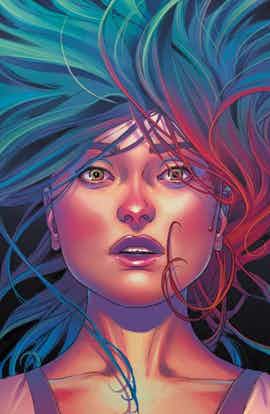
“Mind the Gap #1” is a new Image title from Jim McCann, Rodin Esquejo and Sonia Oback, and one that has already attracted a fair amount of buzz from those looking for the next “Chew” or “Nonplayer.” With a creative team that has had plenty of positive critical attention, all the elements are here for a big hit — but can this comic live up to such lofty expectations?
Although notionally a supernatural thriller centred on Ellis Peterssen, a woman who arrives in hospital after being beaten into a coma, the majority of the book focuses on introducing the supporting cast. Ellis herself is trapped in a strange spiritual hinterland, cut off from the real world — but not alone. It’s a setup with plenty of potential, but it has the unfortunate effect of setting the protagonist apart from everything else going on around her. While the scenes in the real world are characterized by an insistent realism, Ellis’ story is populated by bizarre and surreal moments that don’t really gel with the rest. By the issue’s conclusion it has become clear how the two strands might intersect, but getting there takes a long time. Possibly too long.
McCann’s strengths as a writer do shine through the varied and well-crafted cast members. Each one has an immediately distinct voice, clear motivations and a role to play. There’s not an interchangeable attitude amongst them and it’s apparent that a lot of work has gone into giving us a proper look at everyone in the opening issue. There’s a good reason for this, although McCann takes the frankly bizarre step of spelling it out in the backmatter. It’s hard to say whether he lacks confidence in his own writing or the readers, but it’s a strange thing to reach the end of a comic and find what look like instructions for properly reading it.
McCann uses our time with the supporting cast to set up the book’s wider plots, which deal with everything from personal animosities to medical conspiracies. The high concept makes the series sound like it’ll be in the vein of “Awake” or “Touch”, but the execution reads more like “Grey’s Anatomy” meets “Fringe”. There’s a lot going on, and opening with a double-sized issue is a good idea because it means each plot has the space to get established while we’re still learning about Elle.
Considering that most of the issue takes place either around a hospital bed or within a frequently-featureless void, the art team does its best to keep the story visually interesting, but nothing truly pops until a double page spread two thirds through. Esquejo’s characters all have strong designs and are visually distinctive in both fashion and posture — but they also feel heavily photoreffed and there’s an antiseptic stiffness to their expressions and body language. Oback’s palettes are well-chosen, but her characteristically slick computer-colouring buries Esquejo’s deliberately spare pencils with so much detail that they collapse.
It’s true that no part of “Mind the Gap” fails outright, but it seems somehow weaker than the sum of its parts. There’s not a bad creator in this bunch, but something isn’t catalysing their collaboration. More often than not, it’s visually flat and overly wordy, eager to tell instead of show. McCann’s admissions that this comic started life a TV script are easy to believe and would explain some of the book’s problems: without actors to add charisma, or a camera to convey intimacy, the story too often feels distant and lifeless. On screen, it would have worked. On the page, it doesn’t seem to.

